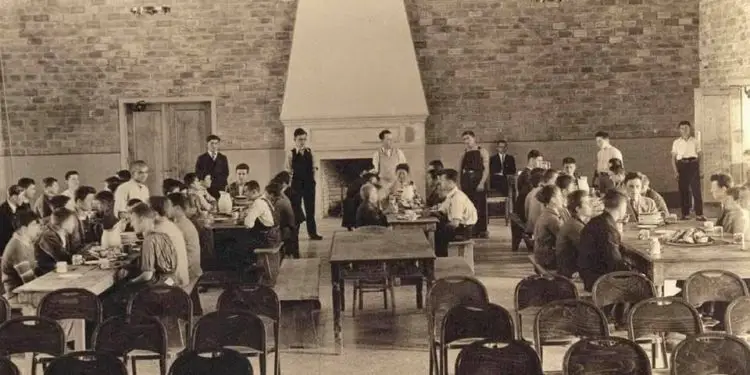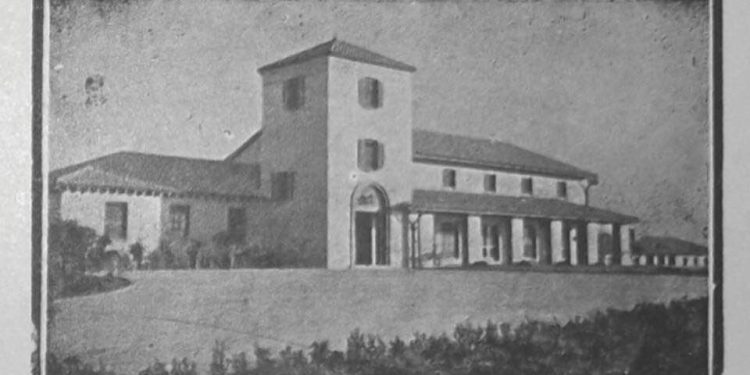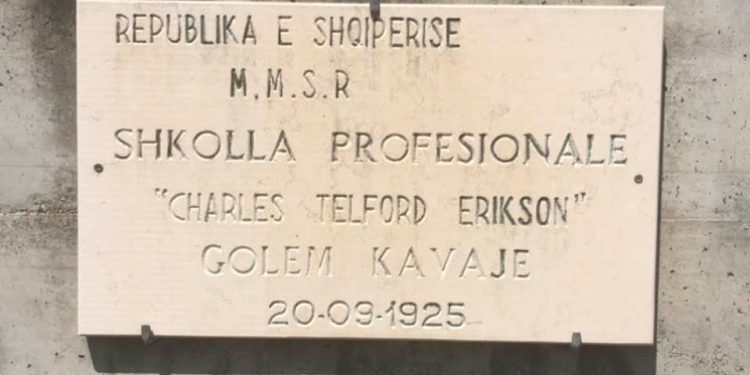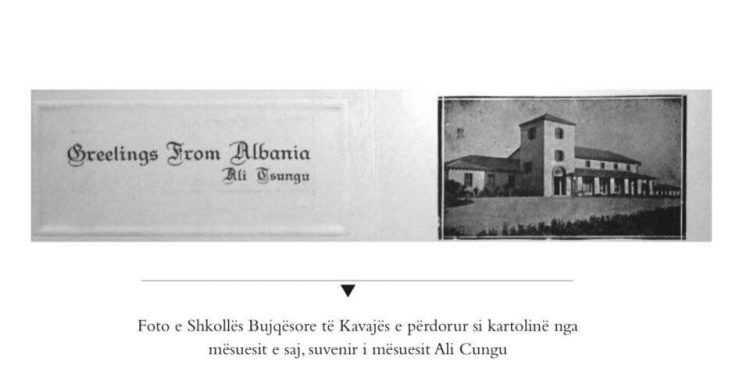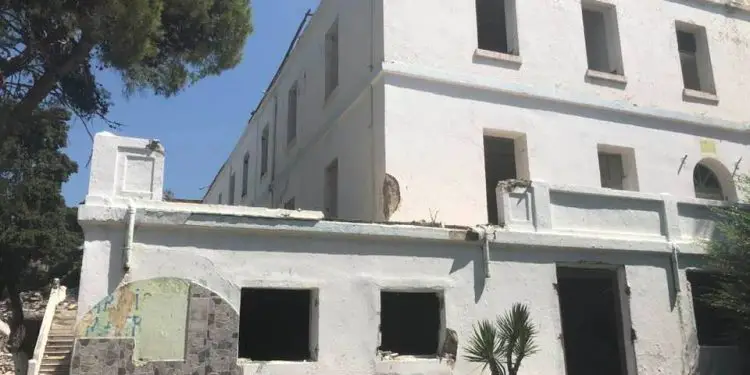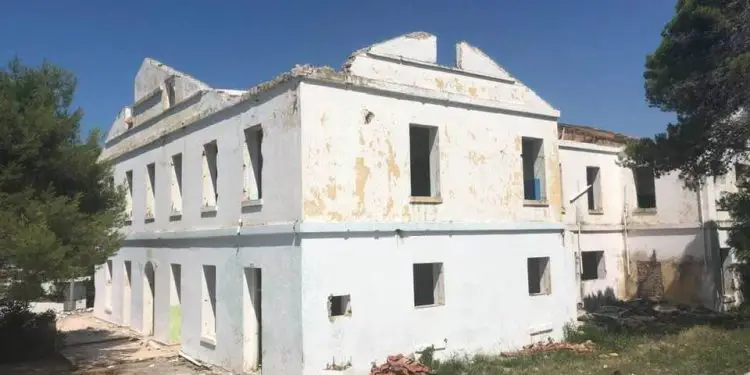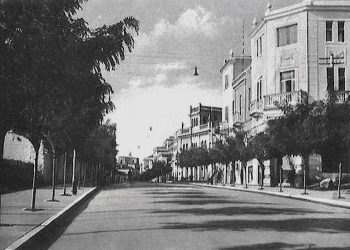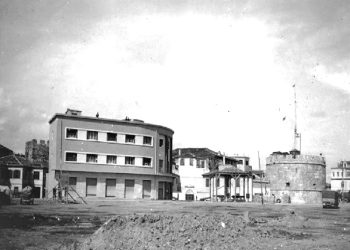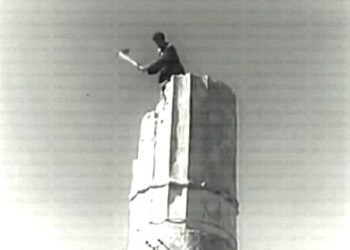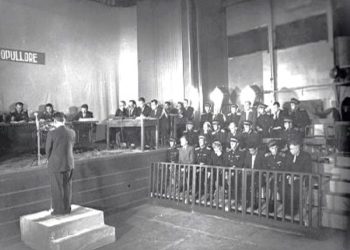 By: Mal Berisha
By: Mal Berisha
Founded on 20.09.1925, it together with the “Harry Fultz” Technical School, was the first evidence of American Investments in Albania and the hearth of education of thousands of agronomists, veterinarians, zootechnicians and specialists in Albanian agriculture;
Its foundations were built with a $ 10,000 donation from 31st US President Herbert Hoover.
In 1925 the school was called the Albanian-American Institute, until 1939; Then the Agricultural Technical School “Ylli i Kuq”; In 2012 it was renamed Charles Telford Erickson Vocational School
Enver Hoxha in his book “Anglo-American Danger for Albania” had stated: “Never again will the enemies of Albania tread here as Charles Telford Erickson did”, ie the founder of this school.
From time to time he went and visited the “Charles Telford Erickson” Agricultural School in Golem, as it seems to me that there I find the traces left by a man who loved Albania with all his strength, making the greatest sacrifices until the loss of a child and wife. These July days while I was on vacation in Qerret, I thought of going once again, among other things, to make a donation with the books I have written for this school. What I saw there terrified me.
The destruction of our Albanian-American heritage.
Following the destruction of the Western heritage and vandalistic acts, the first symbol of Albanian-American relations has collapsed these days: the American Agricultural Institute of Kavaja, established on September 20, 1925. This act was committed in Pandemie’s time, in violation of every law and order and in complete silence, out of the public eye, secretly and for the interests of the construction mafia, to the government.
The care of the American Legation in Tirana for that school:
On July 28, 1922, the American Legation began its work in Tirana. The first American minister was Ulyses Grand – Smith. His staff included Rodgers, J. Donals, First Secretary Minor Georg, and Charles Telford Erickson, a legatee, while local staff included Col. Kuqali, who was shot in 1947 by Enver Hoxha’s regime.
The opening of the American Legation was greeted with great joy as a result of a great sympathy that had been created in Albania for America, due to the protection that President Wilson gave to Albania at the Paris Peace Conference, 1919. On the other hand, the Albanians had achieved to win the sympathy of America through the Pan-Albanian Federation, “VATRA”.
It was VATRA that had sent to the Albanian delegation led by Turkhan Pasha to the Peace Conference in Paris, the prominent missionary and extraordinary friend of Albania, Charles Telford Erickson, a diplomat who also had the honor to deal with the opening of the Legation American in Tirana, in 1922-1923.
Who was Charles Telford Erickson:
For the first time, Erickson came to Albania with his wife Carry and three children, in 1908 and stayed until 1937, sometimes in Albania and sometimes abroad, but without stopping working for our country, which made him even after leaving, until he died at the age of 99, in 1966.
He lived for a while in Korça and then for a year in Tirana, 1908 – 1909. From there he was expelled by the Turks and settled in Elbasan, 1909 – 1912, where he opened an Albanian school. There he was joined by two daughters, but his eldest son died. In 1912, the Serbian occupiers arrested him in Durrës and expelled him as an enemy of Serbia and a friend of the Albanians. In 1913, he returned to Albania as a correspondent for the English magazine The Economist, where he wrote a series of articles on Albania and Kosovo. Erickson responded to the invitation of “VATRA” to join the Albanian delegation that participated in the Paris Peace Conference in 1919.
The story of the defense of Albania by the 28th American President, Woodrow Wilson at the Paris Peace Conference, is completely connected with Erickson’s work after he “bombarded” President Wilson with letters for 15 days in a row, explaining who the Albanians are, while also telling them about the greed of our neighbors in those times. On April 24, 1919, Wilson issued a statement in defense of Albania.
On September 20, 1925, Erickson inaugurated the Albanian-American Institute of Agriculture in Golem, Kavaja. He brings teachers from America and runs the school for years.
In 1931, for his valuable contribution to Albania, King Zog I decorated him with the Order of Skanderbeg’s Knight. After leaving Albania, Erickson was appointed by VATRA as an observer at the United Nations Founding Conference in San Francisco in 1945. He later wrote five books under a common title: “Albania – The Enigma of the Balkans” which remained unpublished in his fund, at the Yale University Divinity Library, in Hartford, Connecticut, America. The author of this article had the honor of discovering, translating, and publishing them in a three-volume book in 2012.
Among all these things he did for our country was the opening of that school as well as another school for girls, in Kavaja.
A short history of the Charles Telford Erickson School in Golem, Kavaja.
The founder of this school had a friendship with Fan Noli. The two of them had come to Albania from America and both agreed that education in Albania was really behind what other Balkan countries had done.
On November 15, 1921, Fan Noli, in the post of Foreign Minister, asked Erickson to submit a proposal in writing, focusing on those areas where Albanian education was to play a major role in society. A few days later, he and Ali Cungu submitted to the Albanian government a proposal to build the Kavaja school. On October 16, 1922, the Albanian government communicated to Erickson that they generally approved of his idea of an Agricultural College, although, as noted, the government was not yet in a suitable financial position.
As funding for the project would come from the United States, Erickson asked the government to provide a state-owned area where the National College of Agriculture would be set up, with a model farm and experimental station near it.
On March 8, 1922, the then Prime Minister, Ahmet Zogu, informed Erickson that he was allowed to choose from a list of eight or ten best state-owned farms to set up the school. On July 4, 1922, Erickson was notified that the government had given him permission for Kavaja land. On May 28, 1923, the Albanian Parliament gave final approval to the Erickson project. In particular, Erickson was grateful for the personal efforts of Ahmet Zogu, who, from the outset, understood the potential impact his project would have.
Erickson left for fundraising in the United States, but Zogu asked him to establish a girls’ school, because, according to him, “if Albania wanted to succeed in the state-building process, women also had to to help with their contribution and efforts. ”
On February 4, 1924, Erickson sent a letter and a copy of the school memorandum to Colonel Ernest T. Bisknell, explaining to the US government that the Albanian government had appointed him to establish the American-Albanian School of Agriculture. which would be financially supported by an American Board of Trustees. Erickson contacted Herbert Hoover, then Secretary of State for Commerce, who later became President of the United States.
On February 9, 1924, Erickson, in a letter to Hoover, stated that Albania’s greatest immediate need was to modernize its agriculture. Erickson writes with so much pain and sympathy for Albanians that no one else has done:
“Albanians are such people who better die than seek, better end in their despair than cry… they are a tragic people, but a heroic race.”
On February 11, 1924, the State Department approved the opening of the school. It said:
“… The project of Mr. Erickson for the establishment of a school for teaching in the field of agriculture and trade in Albania has our approval that comes from the heart. ”
Satisfied with the report released by the State Department, Herbert Hoover decided to give his support to the project, donating $ 10,000 from his personal account, on condition of anonymity, provided that within one year, Erickson raised another $ 100,000 for the school.
Erickson raised $ 350,000, came and built the agricultural school. It was the most organized school in Albania and one of three foreign schools that King Zog did not close during the “Ivanaj Reform” in 1933, due to the national spirit implemented by Erickson and his staff.
After the communists came to power, the name of the Americans disappeared from the face of the earth, while the name of Erickson was banned by order of the dictator. The school continued its work, now under the communist name: “Red Star”.
In 2012, on the occasion of the promotion of the historical book: “Ch.T. Erickson – An American who dedicated his life to Albania”, I managed to bring to Albania, Erickson’s granddaughter, Mery Morris, his nephews, Paul Erickson, the young man, and Donald Jonson, the son of Grace Erickson, born in Albania in 1913. On that occasion, the Ministry of Education named the school:
Charles Telford Erickson Agricultural School.
Today, at the main entrance of the school complex, there is a sign with the initials:
Republic of Albania, M.M.S.R., PROFESSIONAL SCHOOL “Charles Telford Erickson” Golem Kavaja, 20.09.1925. While at the entrance of the new school it bears other initials with the same title: M.A.SH.
A very good investment of the Development Fund has led to the construction of a new school, within this agricultural complex. But the school land has shrunk from aggressive construction leaving no room for students for physical education and no longer for experimental plots.
The 95-year-old Charles Telford Erickson Vocational School building is facing the fate of the National Theater
The old building, built by the Americans, was in very good condition and turned into a dormitory. It carried not only use value but more than that historical value. Of course, the building’s 95-year-old age may have required repairs and maintenance. But in the continuation of the irresistible tendency and temptation to erase everything from our western tradition, “Rilindja” decided to reserve the fate of the National Theater to that school as well.
The moment was ideal: Pandemic and somewhat out-of-sight area and people’s attention. Thus a request of the construction mafia through the corrupt officials associated with it was fulfilled.
The demolition of that building is a shameful attack on the history of our relations with the United States of America. It goes in line with what Enver Hoxha had said about Erickson.
I would like to recall here the speech of the American Ambassador Herman Bernstein, held at that school on the occasion of the inauguration of an addendum, on April 2, 1933: He says, among other things:
“I am especially happy to see this valuable contribution from the generous aid that came from America and brought here to this small country by the Adriatic, with ancient people, and again young people. The foundation that has raised funds for this school has extended its fraternal hand of cooperation with good will and mutual understanding, far from any selfish motive or secret agenda. ”
I do not know if the current staff of the American Embassy is familiar with this vandal – anti – American act of the Albanian authorities today, but of course it will be notified both formally and through this article.
Meanwhile, the Prosecution should immediately launch an investigation: Who destroyed it, who estimated that it should be demolished, why it was demolished without any notice, whether the US Embassy was notified and there was a lot of interest in this symbol of America in Albania?
From the first data it turns out to me that the school is broken, among other things because:
1 – Student housing has passed to a private firm affiliated with the government, which has a hotel nearby, which benefits from corrupt money from the state budget;
2.- A powerful builder will build there with the permission of government agencies, in one of the most picturesque areas of our coast.
3.- The ALUIZM Agency, as a tool of the anti-Western Renaissance, has a special interest in the destruction of this work of our cultural and political heritage, in fulfillment of the renaissance agenda alla the National Theater.
95 years of Albanian-American history are now under the ruins of the “Renaissance”.
Oh God at what time are we living!




